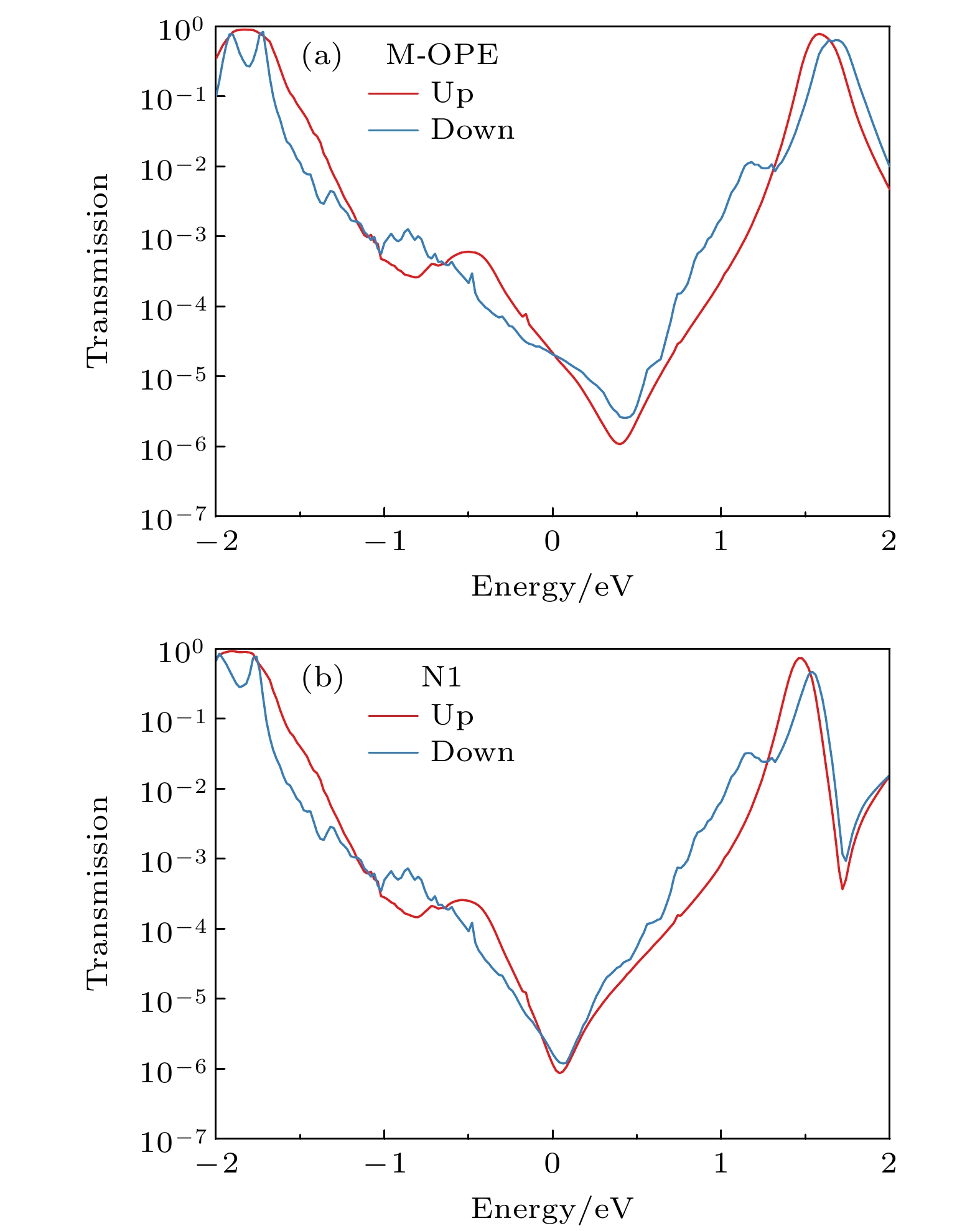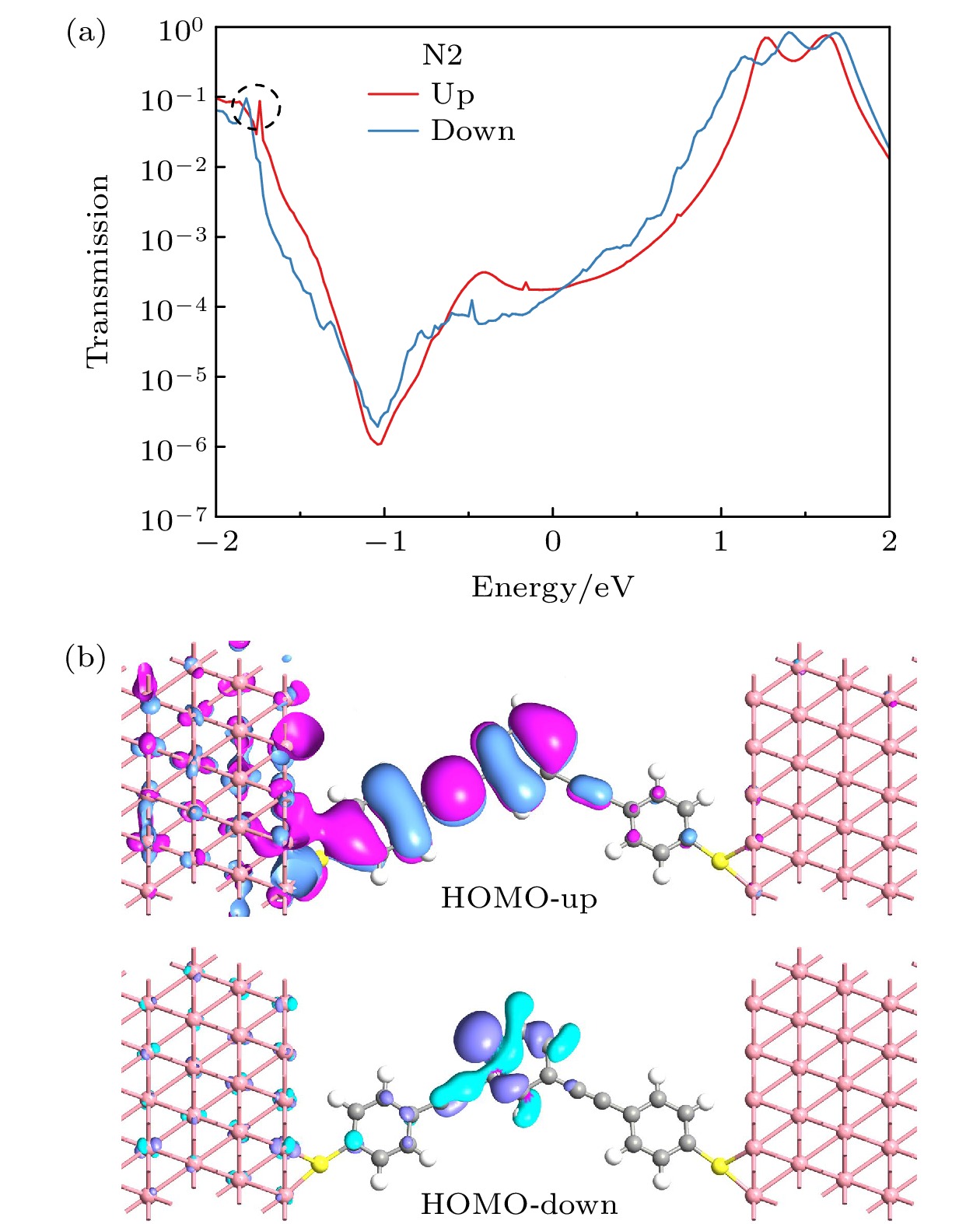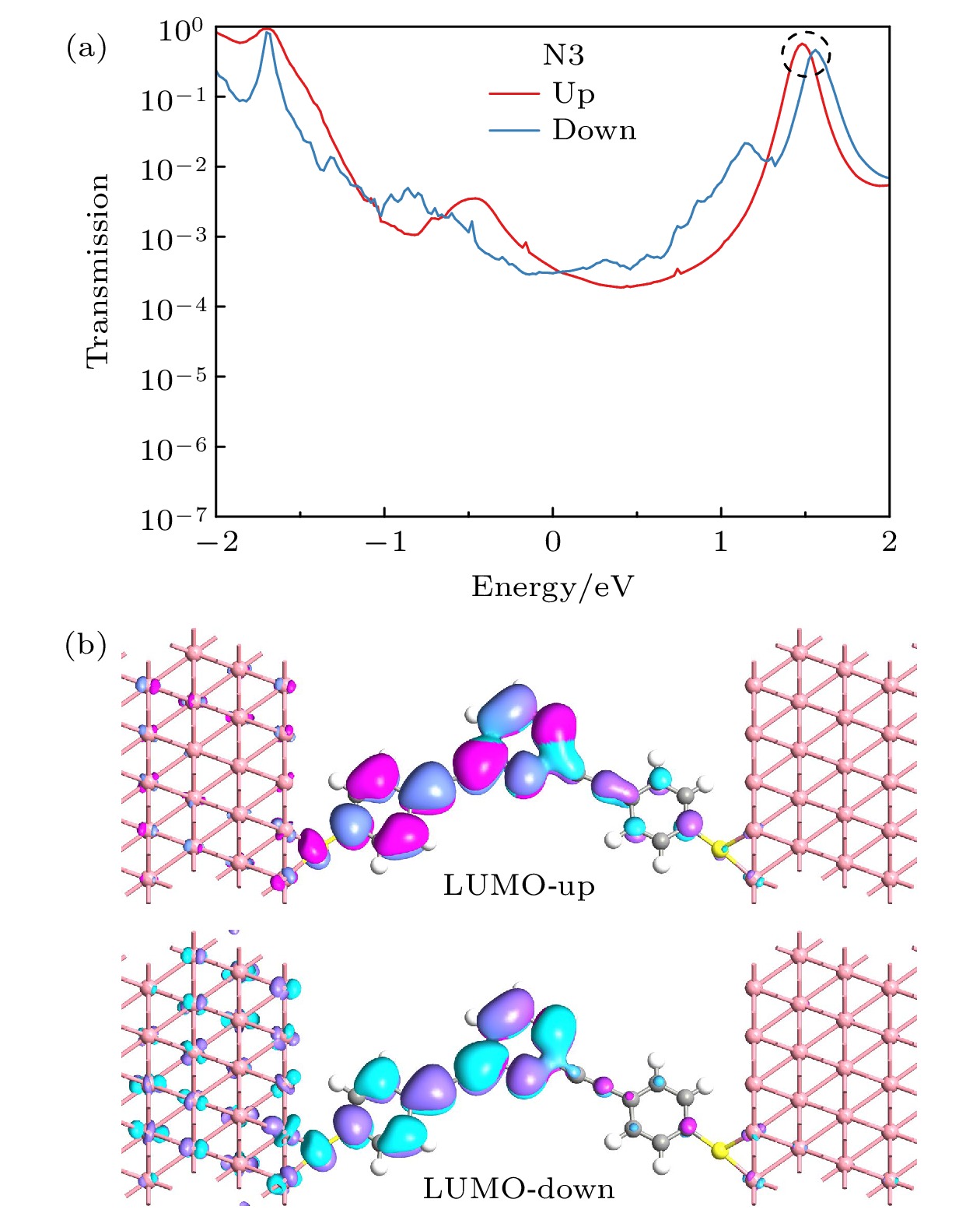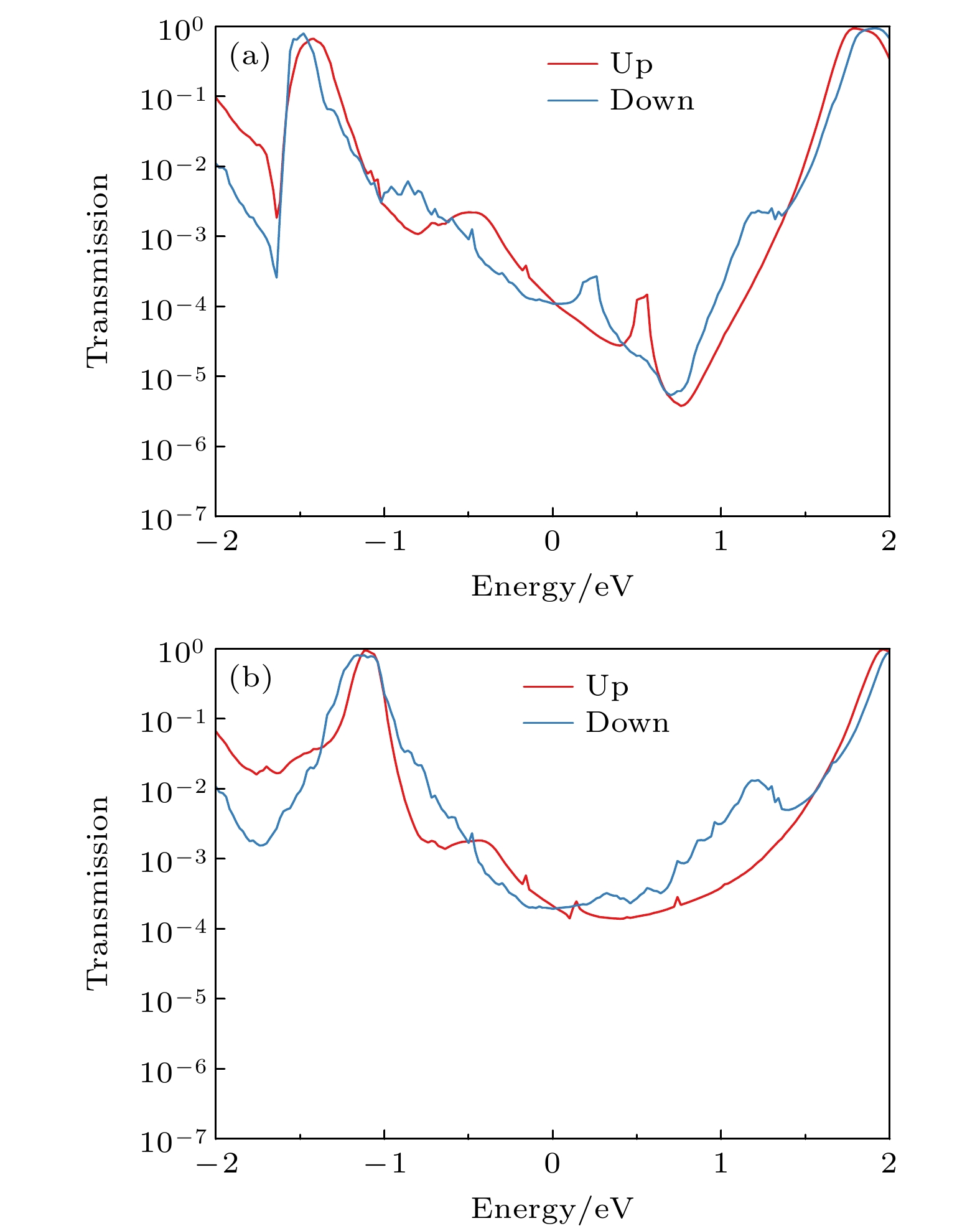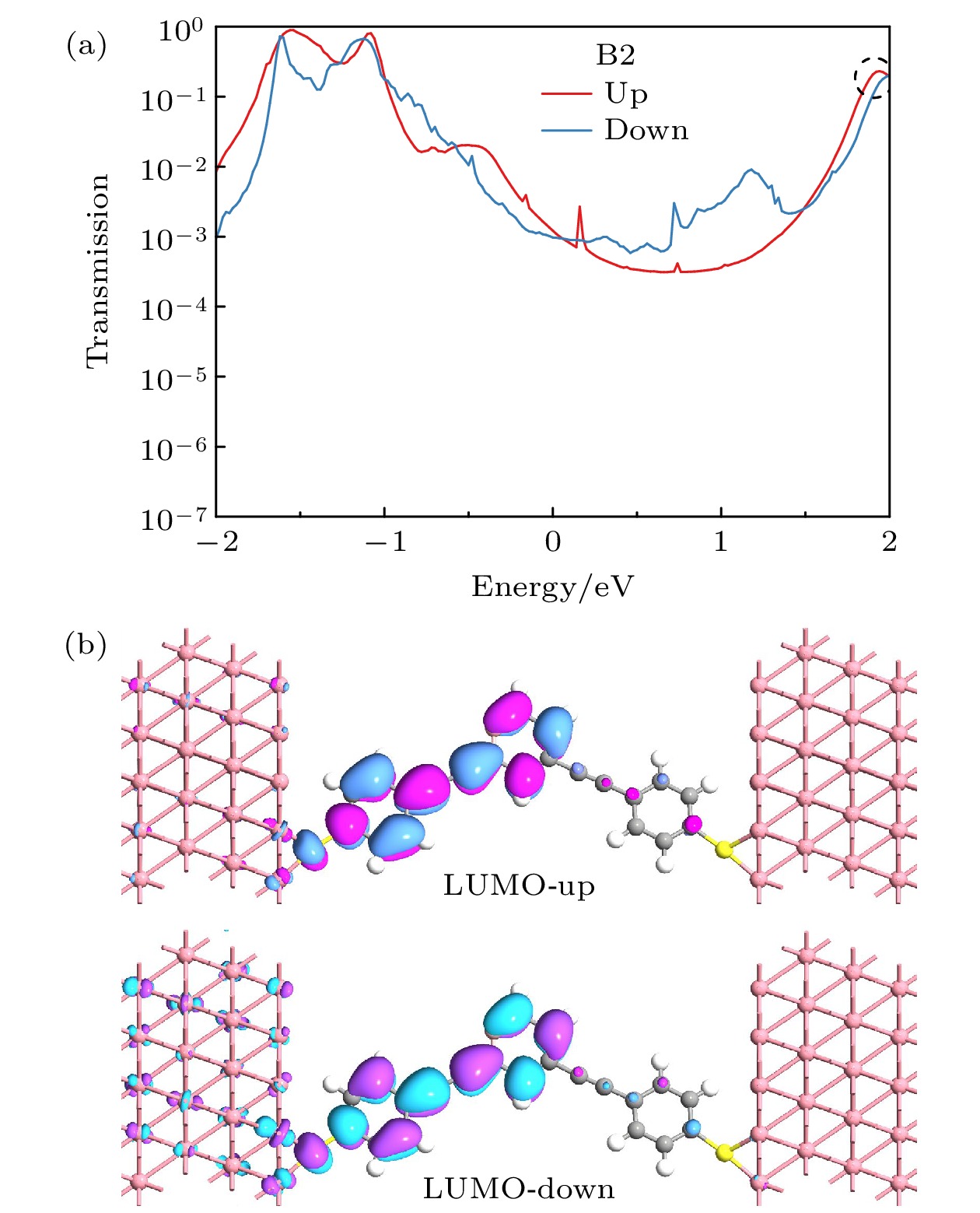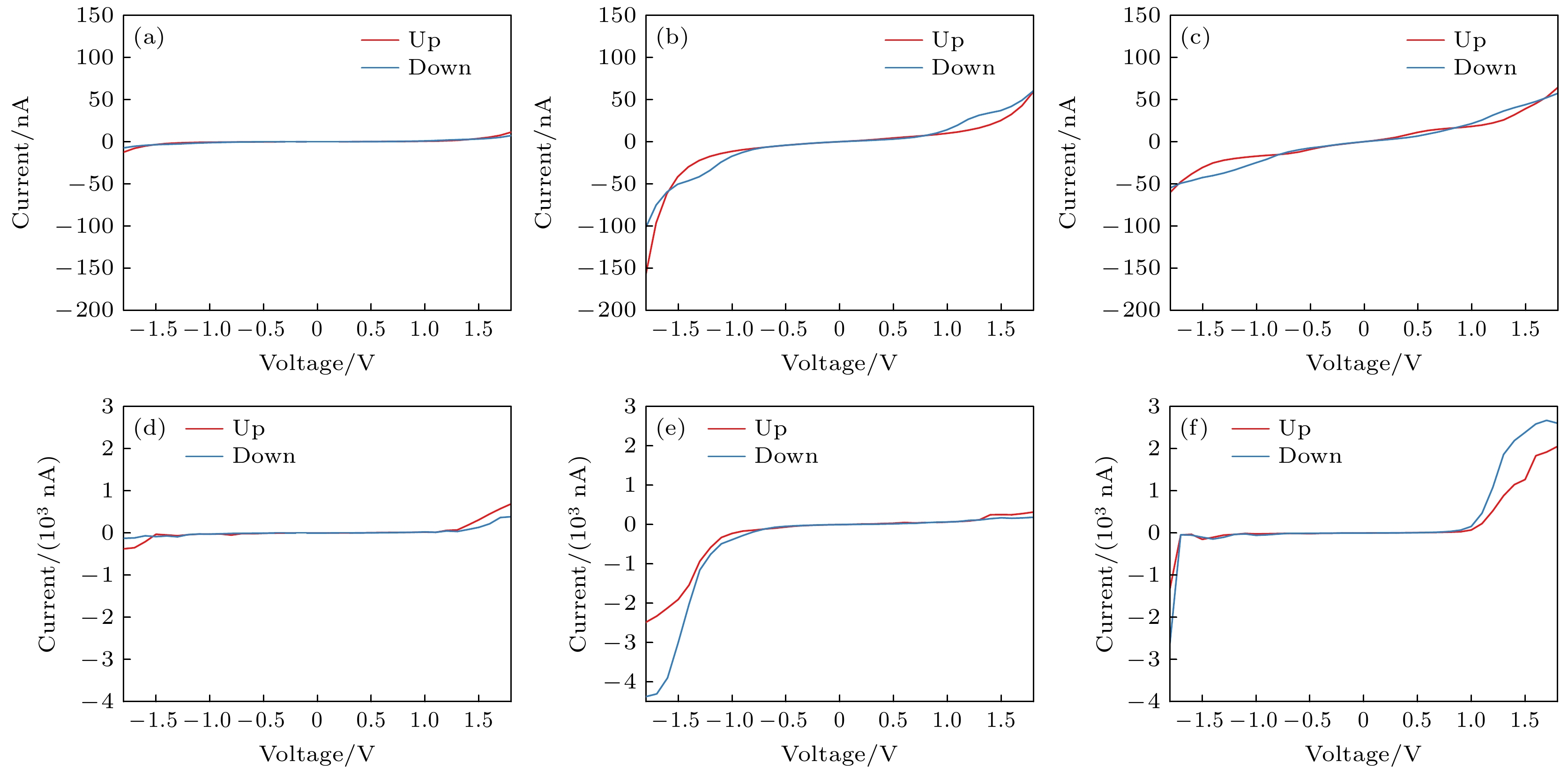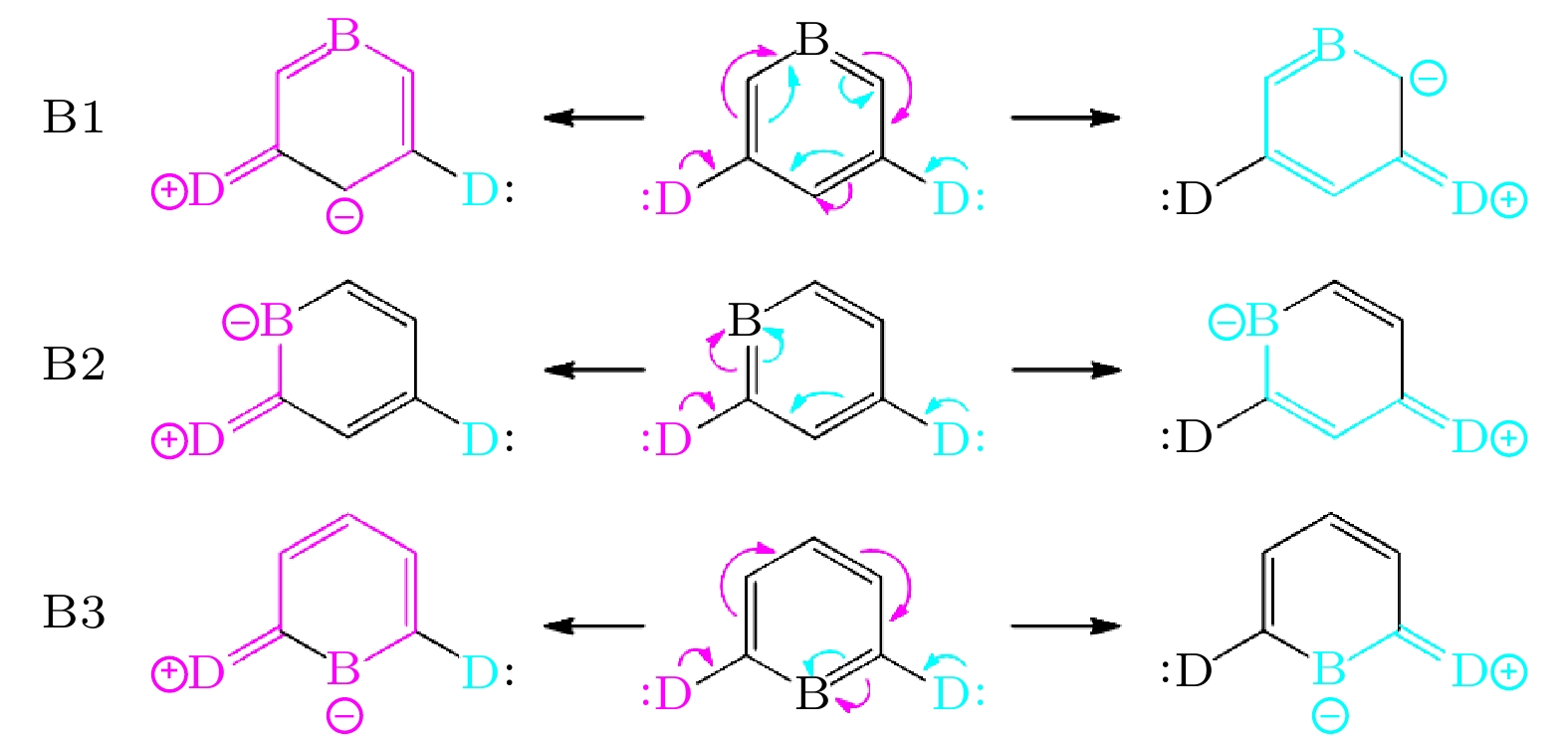-
采用第一性原理计算基础上结合非平衡格林函数方法, 开展了N, B原子取代对间苯乙烯低聚物(M-OPE)分子器件量子干涉与自旋输运的调控研究. 研究结果表明N, B原子在中心苯环不同位置取代对M-OPE分子器件原有的相消量子干涉抑制程度不同. 因此, N, B原子在不同位置取代后的器件电导存在较大差异. 研究还发现B原子取代的器件自旋电流值要明显高于N原子取代的器件, 且B原子在特定位置取代后, 器件在负偏压下的自旋电流值要明显大于正偏压下的自旋电流值, 呈现显著的自旋整流效应. 本文得到的N, B原子取代对分子体系量子干涉和自旋输运调控的物理机制, 可以为杂环芳烃在分子电子学中的进一步应用提供理论指导.In this paper, the first-principles method based on density functional theory and non-equilibrium Green’s function is used to investigate the modulation of quantum interference and spin transport in N and B atom substituted meta-phenylene (M-OPE) molecular devices. The zero bias spin transmission spectrum of M-OPE molecular device shows that highest occupied molecular orbital (HOMO) and lowest unoccupied molecular orbital (LUMO) are located at higher energy positions on both sides of the Fermi level, and there is a clear transmission spectrum valley (anti resonance peak) on the right side of the Fermi level. This indicates that M-OPE molecules are typical destructive quantum interference molecular systems. Research has found that N and B atoms replace carbon atoms at positions 1, 2, and 3 on the central ring of the molecule, which suppress the original destructive quantum interference of M-OPE molecular device to different extents. The substitution of N and B atoms at position 1 has no effect on the original destructive quantum interference of M-OPE molecular device, while the substitution of N and B atoms at positions 2 and 3 significantly suppresses the original destructive quantum interference of M-OPE molecular device. Therefore, there is a significant difference in the electrical conductivity of devices with N and B atoms at different positions, with the order of electrical conductivity values being N2 > N3 > N1 and B2 > B3 > B1. In this study, it is also found that the spin current value of device with B atom substitution is significantly higher than that of device with N atom substitution. After the substitution of B atom at position 2, the spin current value of the device under negative bias is significantly greater than that under positive bias, exhibiting a significant spin rectification effect. Based on the extended curled arrow rule proposed by O’Driscoll et al. to predict the behavior of quantum interference effects, we explain the physical mechanism by which N and B protons at different positions have different effects on the suppression of quantum interference in M-OPE molecular device. The results of the quantum interference and spin transport regulation of molecular systems by the substitution of B and N atoms can provide theoretical guidance for realizing the further application of heterocyclic aromatic hydrocarbons in molecular electronics.
-
Keywords:
- first principles /
- density functional theory /
- molecular device /
- quantum interference /
- spin-transport
[1] 闫瑞, 吴泽文, 谢稳泽, 李丹, 王音 2018 物理学报 67 097301
 Google Scholar
Google Scholar
Yan R, Wu Z W, Xie W Z, Li D, Wang Y 2018 Acta Phys. Sin. 67 097301
 Google Scholar
Google Scholar
[2] Haidar E A, Tawfik S A, Stampfl C, Hirao K, Yoshizawa K, Nakajima T, Nakajima T, Soliman K A, El-Nahas A M 2021 Adv. Theor. Simul. 4 2000203
 Google Scholar
Google Scholar
[3] Su T A, Neupane M, Steigerwald M L, Venkataraman L, Nuckolls C 2016 Nat. Rev. Mater. 1 16002
 Google Scholar
Google Scholar
[4] Li Y, Zhou Y, Li Y, Hong W, Li H 2022 J. Phys. Chem. C 126 6420
 Google Scholar
Google Scholar
[5] 李瑞豪, 刘俊扬, 洪文晶 2022 物理学报 71 067303
 Google Scholar
Google Scholar
Li R H, Liu J Y, Hong W J 2022 Acta Phys. Sin. 71 067303
 Google Scholar
Google Scholar
[6] Liu J, Huang X, Wang F, Hong W 2019 Acc. Chem. Res. 52 151
 Google Scholar
Google Scholar
[7] Fan Z, Chen K 2010 Appl. Phys. Lett. 96 053509
 Google Scholar
Google Scholar
[8] Hirai M, Tanaka N, Sakai M, Yamaguchi S 2019 Chem. Rev. 119 8291
 Google Scholar
Google Scholar
[9] Liu Q, Li J J, Wu D, Deng X Q, Zhang Z H, Fan Z Q, Chen K Q 2021 Phys. Rev. B 104 045412
 Google Scholar
Google Scholar
[10] Tsuji Y, Okazawa K, Kurino K, Yoshizawa K 2022 J. Phys. Chem. C 126 3244
 Google Scholar
Google Scholar
[11] Shubin N, Emelianov A, Uspenskii Y, Gorbatsevich A 2021 Phys. Chem. Chem. Phys. 23 20854
 Google Scholar
Google Scholar
[12] Ding Z K, Zeng Y J, Pan H, Luo N N, Zeng J, Tang L M, Chen K Q 2022 Phys. Rev. B 106 L121401
 Google Scholar
Google Scholar
[13] Pedersen K G L, Strange M, Leijnse M, Hedegård P, Solomon G C, Paaske J 2014 Phys. Rev. B 90 125413
 Google Scholar
Google Scholar
[14] Polakovsky A, Showman J, Valdiviezo J, Palma J L 2021 Phys. Chem. Chem. Phys. 23 1550
 Google Scholar
Google Scholar
[15] Pan H, Ding Z K, Zeng B W, Luo N N, Zeng J, Tang L M, Chen K Q 2023 Phys. Rev. B 107 104303
 Google Scholar
Google Scholar
[16] Qu F Y, Zhao Z H, Ren X R, Zhang S F, Wang L, Wang D 2022 Phys. Chem. Chem. Phys. 24 26795
 Google Scholar
Google Scholar
[17] Baer R, Neuhauser D 2002 J. Am. Chem. Soc. 124 4200
 Google Scholar
Google Scholar
[18] He R, Wang D, Luo N, Zeng J, Chen K Q, Tang L M 2023 Phys. Rev. Lett. 130 046401
 Google Scholar
Google Scholar
[19] 彭淑平, 黄旭东, 刘乾, 任鹏, 伍丹, 范志强 2023 物理学报 72 058501
 Google Scholar
Google Scholar
Peng S P, Huang X D, Liu Q, Ren P, Wu D, Fan Z Q 2023 Acta Phys. Sin. 72 058501
 Google Scholar
Google Scholar
[20] Zhang W, Zhao Z B, Tan M, Adijiang A, Zhong S, Xu X, Zhao T, Ramya E, Sun L, Zhao X, Fan Z, Xiang D 2023 Chem. Sci. 14 11456
 Google Scholar
Google Scholar
[21] Zhang X J, Long M Q, Chen K Q, Shuai Z, Wan Q, Zou B S, Zhang Y 2009 Appl. Phys. Lett. 94 073503
 Google Scholar
Google Scholar
[22] Yang Y, Gantenbein M, Alqorashi A, Wei J, Sangtarash S, Hu D 2018 J. Phys. Chem. C 122 14965
 Google Scholar
Google Scholar
[23] Fan Z Q, Zhang Z H, Deng X Q, Tang G P, Chen K Q 2013 Appl. Phys. Lett. 102 023508
 Google Scholar
Google Scholar
[24] Wang Y H, Huang H, Yu Z, Zheng J F, Shao Y, Zhou X S, Chen J Z, Li J F 2020 J. Mater. Chem. C 8 6826
 Google Scholar
Google Scholar
[25] Wang X Y, Yao X, Narita A, Müllen K 2019 Acc. Chem. Res. 52 2491
 Google Scholar
Google Scholar
[26] Liu X S, Sangtarash S, Reber D, Zhang D, Sadeghi H, Shi J, Xiao Z Y, Hong W J, Lambert C J, Liu S X 2017 Angew. Chem. Int. Ed. 56 173
 Google Scholar
Google Scholar
[27] Chen Z Z, Wu S D, Lin J L, Chen L C, Cao J J, Shao X, Lambert C J, Zhang H L 2023 Adv. Electron. Mater. 9 2201024
 Google Scholar
Google Scholar
[28] Manrique D Z, Huang C, Baghernejad M, Zhao X, Al-Owaedi O A, Sadeghi H 2015 Nat. Commun. 6 6389
 Google Scholar
Google Scholar
[29] Büttiker M, Imry Y, Landauer R, Pinhas S 1985 Phys. Rev. B 31 6207
 Google Scholar
Google Scholar
[30] Smidstrup S, Markussen T, Vancraeyveld P, et al. 2019 J. Phys. Condens. Matter 32 015901
 Google Scholar
Google Scholar
[31] Deng X Q, Zhang Z H, Tang G P, Fan Z Q, Qiu M, Guo C 2012 Appl. Phys. Lett. 100 063107
 Google Scholar
Google Scholar
[32] O’Driscoll L J, Bryce M R 2021 Nanoscale 13 1103
 Google Scholar
Google Scholar
[33] O’Driscoll L J, Sangtarash S, Xu W, Daaoub A, Hong W J, Sadeghi H, Bryce M R 2021 J. Phys. Chem. C 125 17385
 Google Scholar
Google Scholar
[34] Markussen T, Stadler R, Thygesen K S 2010 Nano Lett. 10 4260
 Google Scholar
Google Scholar
[35] von Grotthuss E, John A, Kaese T, Wagner M 2018 Asian J. Org. Chem. 7 37
 Google Scholar
Google Scholar
-
-
[1] 闫瑞, 吴泽文, 谢稳泽, 李丹, 王音 2018 物理学报 67 097301
 Google Scholar
Google Scholar
Yan R, Wu Z W, Xie W Z, Li D, Wang Y 2018 Acta Phys. Sin. 67 097301
 Google Scholar
Google Scholar
[2] Haidar E A, Tawfik S A, Stampfl C, Hirao K, Yoshizawa K, Nakajima T, Nakajima T, Soliman K A, El-Nahas A M 2021 Adv. Theor. Simul. 4 2000203
 Google Scholar
Google Scholar
[3] Su T A, Neupane M, Steigerwald M L, Venkataraman L, Nuckolls C 2016 Nat. Rev. Mater. 1 16002
 Google Scholar
Google Scholar
[4] Li Y, Zhou Y, Li Y, Hong W, Li H 2022 J. Phys. Chem. C 126 6420
 Google Scholar
Google Scholar
[5] 李瑞豪, 刘俊扬, 洪文晶 2022 物理学报 71 067303
 Google Scholar
Google Scholar
Li R H, Liu J Y, Hong W J 2022 Acta Phys. Sin. 71 067303
 Google Scholar
Google Scholar
[6] Liu J, Huang X, Wang F, Hong W 2019 Acc. Chem. Res. 52 151
 Google Scholar
Google Scholar
[7] Fan Z, Chen K 2010 Appl. Phys. Lett. 96 053509
 Google Scholar
Google Scholar
[8] Hirai M, Tanaka N, Sakai M, Yamaguchi S 2019 Chem. Rev. 119 8291
 Google Scholar
Google Scholar
[9] Liu Q, Li J J, Wu D, Deng X Q, Zhang Z H, Fan Z Q, Chen K Q 2021 Phys. Rev. B 104 045412
 Google Scholar
Google Scholar
[10] Tsuji Y, Okazawa K, Kurino K, Yoshizawa K 2022 J. Phys. Chem. C 126 3244
 Google Scholar
Google Scholar
[11] Shubin N, Emelianov A, Uspenskii Y, Gorbatsevich A 2021 Phys. Chem. Chem. Phys. 23 20854
 Google Scholar
Google Scholar
[12] Ding Z K, Zeng Y J, Pan H, Luo N N, Zeng J, Tang L M, Chen K Q 2022 Phys. Rev. B 106 L121401
 Google Scholar
Google Scholar
[13] Pedersen K G L, Strange M, Leijnse M, Hedegård P, Solomon G C, Paaske J 2014 Phys. Rev. B 90 125413
 Google Scholar
Google Scholar
[14] Polakovsky A, Showman J, Valdiviezo J, Palma J L 2021 Phys. Chem. Chem. Phys. 23 1550
 Google Scholar
Google Scholar
[15] Pan H, Ding Z K, Zeng B W, Luo N N, Zeng J, Tang L M, Chen K Q 2023 Phys. Rev. B 107 104303
 Google Scholar
Google Scholar
[16] Qu F Y, Zhao Z H, Ren X R, Zhang S F, Wang L, Wang D 2022 Phys. Chem. Chem. Phys. 24 26795
 Google Scholar
Google Scholar
[17] Baer R, Neuhauser D 2002 J. Am. Chem. Soc. 124 4200
 Google Scholar
Google Scholar
[18] He R, Wang D, Luo N, Zeng J, Chen K Q, Tang L M 2023 Phys. Rev. Lett. 130 046401
 Google Scholar
Google Scholar
[19] 彭淑平, 黄旭东, 刘乾, 任鹏, 伍丹, 范志强 2023 物理学报 72 058501
 Google Scholar
Google Scholar
Peng S P, Huang X D, Liu Q, Ren P, Wu D, Fan Z Q 2023 Acta Phys. Sin. 72 058501
 Google Scholar
Google Scholar
[20] Zhang W, Zhao Z B, Tan M, Adijiang A, Zhong S, Xu X, Zhao T, Ramya E, Sun L, Zhao X, Fan Z, Xiang D 2023 Chem. Sci. 14 11456
 Google Scholar
Google Scholar
[21] Zhang X J, Long M Q, Chen K Q, Shuai Z, Wan Q, Zou B S, Zhang Y 2009 Appl. Phys. Lett. 94 073503
 Google Scholar
Google Scholar
[22] Yang Y, Gantenbein M, Alqorashi A, Wei J, Sangtarash S, Hu D 2018 J. Phys. Chem. C 122 14965
 Google Scholar
Google Scholar
[23] Fan Z Q, Zhang Z H, Deng X Q, Tang G P, Chen K Q 2013 Appl. Phys. Lett. 102 023508
 Google Scholar
Google Scholar
[24] Wang Y H, Huang H, Yu Z, Zheng J F, Shao Y, Zhou X S, Chen J Z, Li J F 2020 J. Mater. Chem. C 8 6826
 Google Scholar
Google Scholar
[25] Wang X Y, Yao X, Narita A, Müllen K 2019 Acc. Chem. Res. 52 2491
 Google Scholar
Google Scholar
[26] Liu X S, Sangtarash S, Reber D, Zhang D, Sadeghi H, Shi J, Xiao Z Y, Hong W J, Lambert C J, Liu S X 2017 Angew. Chem. Int. Ed. 56 173
 Google Scholar
Google Scholar
[27] Chen Z Z, Wu S D, Lin J L, Chen L C, Cao J J, Shao X, Lambert C J, Zhang H L 2023 Adv. Electron. Mater. 9 2201024
 Google Scholar
Google Scholar
[28] Manrique D Z, Huang C, Baghernejad M, Zhao X, Al-Owaedi O A, Sadeghi H 2015 Nat. Commun. 6 6389
 Google Scholar
Google Scholar
[29] Büttiker M, Imry Y, Landauer R, Pinhas S 1985 Phys. Rev. B 31 6207
 Google Scholar
Google Scholar
[30] Smidstrup S, Markussen T, Vancraeyveld P, et al. 2019 J. Phys. Condens. Matter 32 015901
 Google Scholar
Google Scholar
[31] Deng X Q, Zhang Z H, Tang G P, Fan Z Q, Qiu M, Guo C 2012 Appl. Phys. Lett. 100 063107
 Google Scholar
Google Scholar
[32] O’Driscoll L J, Bryce M R 2021 Nanoscale 13 1103
 Google Scholar
Google Scholar
[33] O’Driscoll L J, Sangtarash S, Xu W, Daaoub A, Hong W J, Sadeghi H, Bryce M R 2021 J. Phys. Chem. C 125 17385
 Google Scholar
Google Scholar
[34] Markussen T, Stadler R, Thygesen K S 2010 Nano Lett. 10 4260
 Google Scholar
Google Scholar
[35] von Grotthuss E, John A, Kaese T, Wagner M 2018 Asian J. Org. Chem. 7 37
 Google Scholar
Google Scholar
计量
- 文章访问数: 4762
- PDF下载量: 132
- 被引次数: 0














 下载:
下载:
